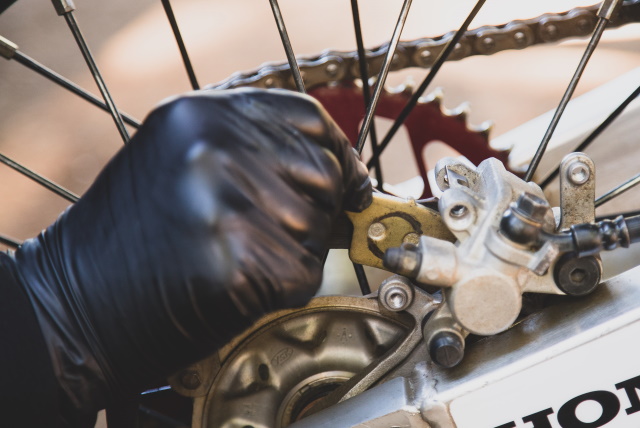
Go ahead and take a look at the brake system on your dirt bike.
Stopping your bike on demand rests solely upon the operation of a relatively small piece of metal that fully squeezes two brake pads against spinning rotors. The caliper, though one part of many that make a whole system, arguably represents the heart and soul of the brakes.
The caliper houses the brake pads and contains one or two pistons along with a mess of pins and clips that function in conjunction when a rider presses the brake lever (front brakes) or presses on the brake pedal (rear). Most Motocross bikes use a single piston caliper for the rear brakes and a dual piston front caliper. (In many respects, you should look at the brake calipers as the brake caliper assembly since it contains a variety of parts that function as a whole.) A bad caliper therefore not only affects your ability to safely and effectively stop the bike but impacts the other parts that make up the whole brake system.
So, the next time you think the brake pads need changing take a really good look at the calipers because the next set of pads might dissolve pretty quickly or perhaps you don't actually need new pads.
Your brake problems might not be from the pads
Bad Brake Caliper Symptoms
The symptoms of a bad brake caliper feel and sometimes sound much like bad brake pads. In fact, any past experience - if you can recall - of bad brake pads whether on your dirt bike or even a regular vehicle could have resulted from bad calipers. At any rate, irregular or reduced braking power, a warping or wobbling feeling when applying the brakes, uneven pad wear and high-pitched sounds when applying the brakes all point to bad calipers. One leaking piston on a dual piston caliber causes the brakes to feel soft and the brake lever feels normal at first when clutched but then fades and drops even further past the regular resistance point.
Most riders sound the alarm after "feeling" uneven pad wear when the brakes drag or experiencing resistance in the lever. At this point, however, you likely have more damage than not.
Therefore, a visual inspection of your dirt bike's brake system can reveal problematic calipers before extensive damage sets in. (A tire changing session offers a great opportunity.) Look for abnormal brake pad wear by comparing the front and rear of the pad (not the front and rear pads). Keep in mind, the side of the pad closest to the brake piston wears faster than the other side but you should still see even wear.
Brake fluid leaking from the caliper or anywhere around the brake system also indicates an issue with the caliper. Check for any resistance or friction from the pads, which indicates uneven wear, by spinning the front and back wheel with the dirt bike on a stand.
What Causes Calipers to Go Bad?
Heat and dirt cause calipers to age prematurely and of course time eventually catches up with the best of parts. Excessive braking, riding regularly in dusty conditions and failure to appropriately clean your dirt bike after every ride all contribute to breaking down the calipers.
Heat and dirt help erode the seals around the piston (that pushes the caliper holding the brake pad against the rotor) resulting in leaking brake fluid. The piston(s) could also stick preventing the calipers from either engaging or disengaging the pads from the rotor. In the two piston front brake system this can result in heavily uneven pad wear, a damaged or warped rotor or a broken caliper since one piston functions appropriately while the other remains in place.
Finally, a number of pins, retaining springs and other hardware that keep the brake pad situated and positioned correctly can ruin calipers when pulling the pads to one side or the other or not allowing the pads to move at all.
Clean and grease the caliper pistons during every brake pad replacement and change the brake fluid according to the bike manufacturer's recommended intervals since old brake fluid helps deteriorate seals and thus contributes to ruining the calipers. Most dirt bikes require DOT 4 brake fluid but double check with the owner's manual.
When It's Not the Caliper
Not to throw the breaks on the bad caliper culprit but sometimes the hanger, located in the caliper assembly which allows the caliper to move freely back and forth on a greased pin, goes bad. Again, wear and tear from dirt and heat deteriorate the hanger impacting the proper function of the caliper. The hangers need occasional greasing or replaced if the surrounding rubber housing, or rubber boot, has deteriorated and no longer protects the hanger from the elements.
Regular cleaning and routine maintenance keep the brake system functioning properly and prevent premature wear and tear on the calipers and other parts. But, when brake pads no longer show uniform wear or have a quicker than usual turnaround time, check the calipers because riding without good working brakes is scary and foolish.
Need more stopping power? Check out these related articles on brakes:









